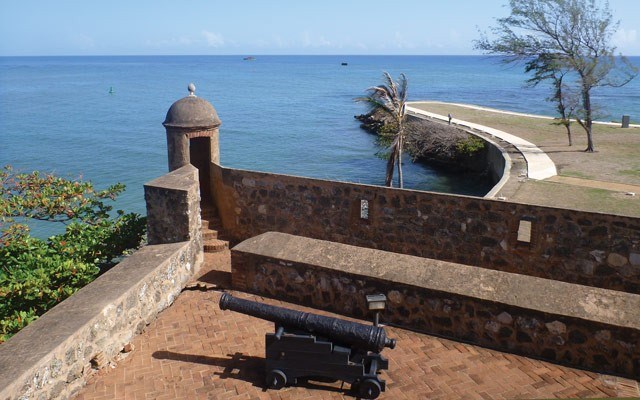Ican most kindly describe Puerto Plata as a little rough around the edges — likely why most tourists stick to the East Coast instead of venturing north in Dominican Republic.
But, hey, to me that is a huge part of its charm. I want an authentic experience and not a sun-blurred sojourn amid coconut-smelling tanners lined up like smelt at a fish fry.
Don't get me wrong. With cyan sky dipping into clear cerulean sea, bordered by miles of caramel beaches, this coast delivers everything sun worshippers want in the Caribbean.
It's just that there is so much more to explore given that this pretty seascape has a gritty history (corsairs and conquistadors; wars with Spain, Haiti, France and the U.S.), that has resulted in a meaty medley of architecture, museums, monuments and cuisine infused with many cultures.
After being destroyed many times (starting in 1605 when Fernando III was compelled to exorcize vicious pirates), today's city was created in the late 1800s, which explains the collection of pastel-painted Victorian buildings in the Old City that piques my architectural eye.
It's like strolling through life-size doll houses, all decked out with elaborate "gingerbread" trim, lace filigrees and fancy balconies.
I'm delighted to be able to peek inside a few. Like the whimsical building housing the Luperon Museum, honouring the hero who led the War of Restoration to gain independence from Spain. The artifacts are interesting but I most enjoy trying to chat, with my smattering of Spanish, with the young people wearing period costumes. They look majestic, if shiny with sweat, in their layers of taffeta and tuxedos.
The Amber Museum, located in a wedding cake-like white mansion, contains a unique collection of rare Dominican amber. I half listen to the
guide describing how amber is tree sap hardened for millions of years. I'm intrigued by the insects embedded in amber, especially a 40-cm lizard.
The museum sells amber. Instead, I suss out the best place to buy Larimar (blue pectolite found only in an old DR volcano) and watch as a local artisan patiently smooths the stones before setting in silver. I'm similarly entranced by the craftsman, in a tiny shop, who carefully concocts cigars. According to aficionados (of which I am not one), DR cigars are some of the world's most superlative. I don't smoke, but I buy one to express my appreciation for the art form. The unlit tobacco smells sublime.
A short walk along the Malecon takes me to San Filipe Fort, the city's main colonial monument. I clamber over stone walls and slip into buttresses and can almost hear the echoes of gunfire and ghosts. The place was designed to protect the city against the incursions of bandits and pirates that continuously terrified inhabitants of Puerto Plata. (Later, it was used as a prison.) So, not surprisingly, the vistas over the vast sea are incredible. I pull out my camera and shoot away, grateful I am not dodging bullets or cannon fire.
Having had my fill of museums and monuments, I'm hungry for more literal sustenance.
I think the region's diversity is best experienced in its food, a blend of the Taíno legacy, Spanish conquistadores' cooking and that of their African slaves, plus the influences of other European and Asian nations.
At Mares, local chef Heinsen, whose resto is in his home, says his aim is to combine "fantasy with freshness" as he serves up creative cosmopolitan cuisine and sushi rolls stuffed with local vegetables in addition to traditional dishes like mofonguito (fried green plantain) with goat marinated in Brugal rum (the nearby factory offers tastings of its farm to bottle premium portfolio, made by fifth generation masters). I dine outside by the pool, lined with trees strung with fairy lights, after photographing my way through the orchid garden.
For something more affordable, I will head to Playa Maimon, known for fresh seafood from the surrounding fishing villages. Think lobster as big as your calf, red snapper you can pick from the cooler and tostones (twice fried plantain slices). Wash it all down with a grande Presidente or a little mamajuana, a rum, red wine and honey concoction soaked in a bottle with tree bark and herbs. DR's version of sangria — but better.
With groaningly full belly, I stroll an empty beach. The soft wish of waves and silkiness of sand between my toes, makes me think maybe tomorrow should be a beach day.
If you go
West Jet flies from Vancouver to Puerto Plata (POP) via Toronto and Air Canada via Montreal.
Casa Colonial, about six kilomtres from downtown Puerto Plata on Playa Dorada, is a 50-room boutique hotel with a quiet beach setting and rooftop infinity pool. Rooms, which start at US$250, are airy and elegant. (French-Caribbean food at Lucia restaurant is not worth the price.)
Blue Jack Tar, 3 km from Puerto Plata, is laid back and perfectly acceptable — especially for $100 a night, including breakfast — a multi-course menu with hot entrees plus a buffet of fruit, pastries, cheeses and cold meats. It is set on a golf course and beside a pretty beach. The Green Jack resto is superb, especially for the price. Light and bright ceviche, fresh seafood in a variety of preparations, gooey pastelons as big as your head (must share!), the best avocado salad I have ever had, perfectly prepared risottos, gelato made from local fruits and so much more.
Best time to go: March to June, and October to November to avoid prime tourist seasons and hurricane season (August to September). Average temps are 27 degrees C, dipping to 23 degrees in January.




